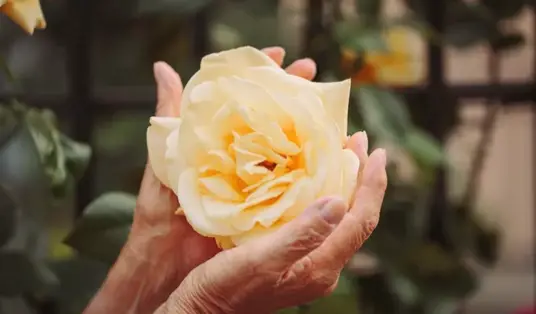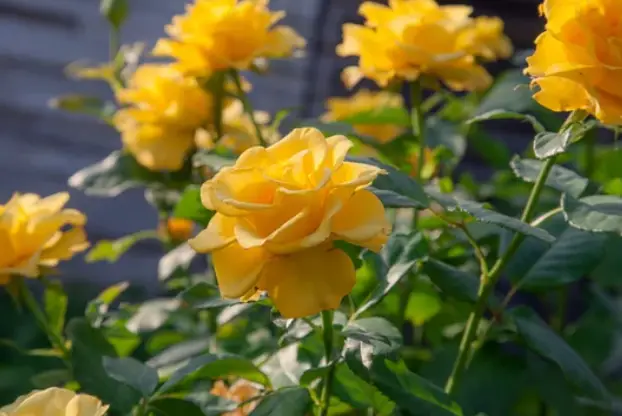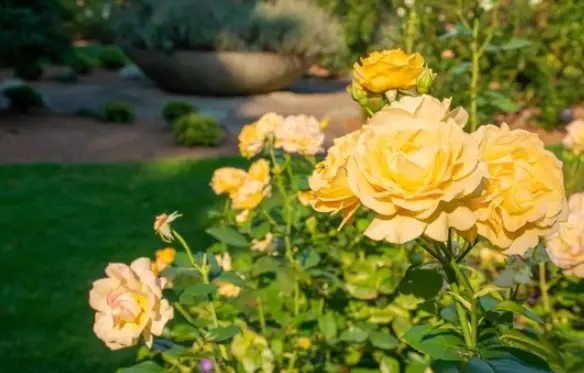Yellow roses, with their radiant hues and timeless charm, have long been cherished as symbols of friendship, happiness, and the warmth of sunshine.
Their presence in any garden brings an instant sense of joy and elegance.
We will guide you through every step of this fascinating adventure, from choosing the ideal seeds and setting up your garden’s foundation through the germination, care, and final blooming of your yellow rose bushes.
While enjoying the suspense of witnessing your garden erupt into a symphony of yellow.
You will also learn the tricks of encouraging delicate seedlings into sturdy, golden-hued rose bushes along the way.

Growing Yellow Roses
Yellow Rose Varieties
- Hybrid Tea Roses: Known for their classic shape and strong fragrance, hybrid tea roses are a popular choice for many gardeners.
- Floribunda Roses: These roses produce clusters of smaller blooms and are known for their prolific flowering.
- Climbing Roses: Ideal for trellises and fences, climbing roses add vertical interest to your garden.
- Shrub Roses: Compact and hardy, shrub roses are easy to care for and perfect for landscape design.
- Old Garden Roses: These heirloom roses offer a sense of nostalgia with their vintage charm.
Where to Buy Yellow Rose Seeds
- Local Nurseries and Garden Centers
- Online Seed Retailers
- Rose Societies and Exchanges
Choosing High-Quality Seeds
- Look for seeds from reputable sources that specialize in roses.
- Check for freshness and viability by reviewing the seed packaging and expiration date.
- Consider purchasing certified organic or heirloom yellow rose seeds for a more natural and diverse garden.
Preparing Your Garden for Yellow Roses
It’s time to set up your garden or growing area after choosing the ideal yellow rose seeds to offer your roses the greatest possible start.
Choosing the Right Location
- Yellow roses thrive in areas with at least six hours of direct sunlight per day.
- Ensure good air circulation to prevent common rose diseases.
- Consider the mature size of the rose bush when selecting a location.
Soil Preparation
- Roses prefer well-drained soil with a pH between 6.0 and 6.5.
- Incorporate organic matter such as compost to improve soil fertility.
- Test your soil and amend it accordingly to provide the ideal growing conditions.
Tools and Equipment
- Gather essential gardening tools, including a spade, pruners, gloves, and a watering can.
- Invest in trellises or support structures if you’re growing climbing roses.
- Consider mulch to help retain soil moisture and suppress weeds.
Germinating Yellow Rose Seeds
Germination is the crucial first step in growing yellow roses from seeds. Understanding the process and providing the right conditions will increase your chances of success.
Indoor vs. Outdoor Germination
- Indoor germination allows for better control over temperature and moisture.
- Outdoor germination is possible in warmer climates but may be riskier due to unpredictable weather.
The Stratification Process
- Many rose seeds require stratification, a period of cold treatment to break dormancy.
- Place seeds in a plastic bag with damp vermiculite or perlite and refrigerate for several weeks.
Sowing Rose Seeds
- Fill seed trays or pots with a well-draining seed-starting mix.
- Plant seeds about 1/4 inch deep and water gently.
- Cover with a plastic dome or plastic wrap to create a mini-greenhouse effect.
Maintaining the Right Conditions
- Maintain a consistent temperature of around 70°F (21°C).
- Keep soil consistently moist but not waterlogged.
- Be patient; germination can take several weeks.
Transplanting Seedlings
Once your rose seedlings have developed their first true leaves, it’s time to transplant them into individual pots or into your garden.
Timing Is Crucial
- Wait until seedlings have at least two sets of true leaves before transplanting.
- This is typically 6-8 weeks after germination.
Preparing Seedling Pots
- Use biodegradable pots or plastic pots with drainage holes.
- Fill with a well-draining potting mix.
Transplanting Process
- Gently remove seedlings from their original containers, taking care not to damage the fragile roots.
- Plant seedlings in new pots at the same depth as they were in the original tray.
- Water thoroughly after transplanting.
Caring for Your Yellow Rose Seedlings

To ensure healthy growth, your yellow rose seedlings need proper care and attention.
Watering
- Keep the soil consistently moist but not waterlogged.
- Water at the base of the plant to avoid wetting the leaves, which can lead to diseases.
Fertilizing
- Use a balanced, slow-release fertilizer to provide essential nutrients.
- Follow the recommended application rates on the fertilizer label.
Sunlight and Temperature
- Ensure seedlings receive at least six hours of sunlight per day.
- Maintain a temperature between 60-70°F (15-21°C) for optimal growth.
Pruning and Training
- As seedlings grow, prune any weak or damaged growth to encourage strong, healthy stems.
- Consider staking or trellising if growing climbing roses.
Dealing with Common Rose Growing Challenges
Yellow roses, like all roses, can face various challenges such as pests, diseases, weeds, and environmental stressors.
Pests and Diseases
- Monitor for common rose pests like aphids, spider mites, and rose beetles.
- Identify and treat diseases promptly, using organic or chemical remedies as needed.
Weeds
- Mulch around your rose bushes to suppress weed growth.
- Hand-weed or use a hoe to remove any weeds that do appear.
Drought and Overwatering
- Maintain a consistent watering schedule to prevent drought stress.
- Avoid overwatering, which can lead to root rot and other issues.
Pruning and Shaping Yellow Rose Bushes

Pruning is an essential part of rose care that helps maintain shape, encourage flowering, and remove dead or diseased growth.
Pruning Basics
- Prune in late winter or early spring before new growth begins.
- Remove dead, diseased, or crossing branches.
- Cut at a 45-degree angle just above an outward-facing bud.
Shaping Your Yellow Rose Bush
- Decide on the desired shape, whether it’s a bush, a standard, or a climber.
- Regular pruning can help maintain the shape and size you prefer.
Enjoying Your Yellow Rose Garden
As your yellow roses mature and thrive, you can enjoy their beauty in various ways.
Cut Roses for Bouquets
- Harvest roses early in the morning when they are freshest.
- Use sharp pruners to make clean cuts.
- Arrange them in vases or create stunning bouquets.
Landscaping Ideas
- Incorporate yellow roses into your landscape design, whether as focal points or borders.
- Combine them with other flowers and shrubs for a harmonious garden.
Wrap Up
Growing yellow roses from seeds is a fulfilling endeavor that allows you to witness the entire life cycle of these beautiful flowers, from tiny seeds to vibrant blooms.
Remember that patience and dedication are key to success in gardening, and with time, your efforts will be rewarded with the delightful sight of yellow roses in full bloom.
So, roll up your sleeves, gather your supplies, and embark on the journey of growing your very own yellow rose garden from seeds.




